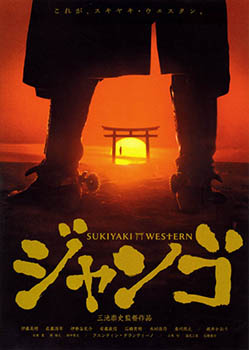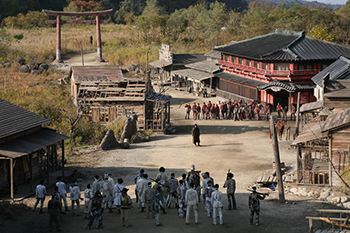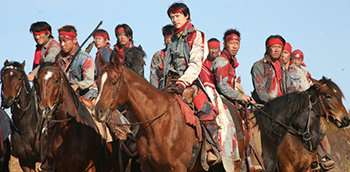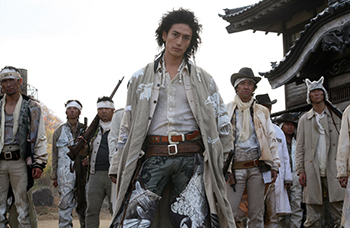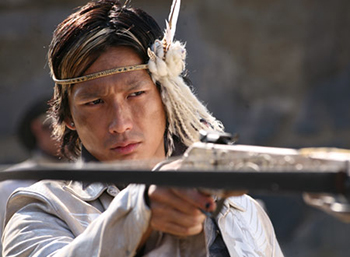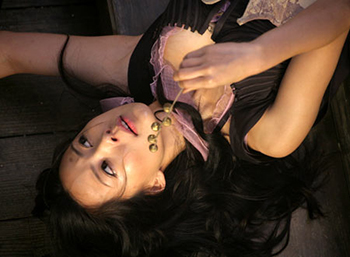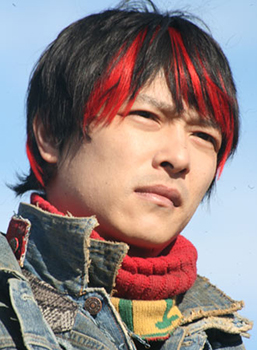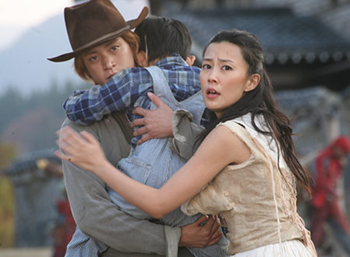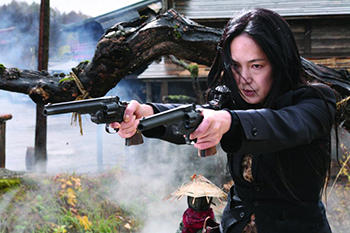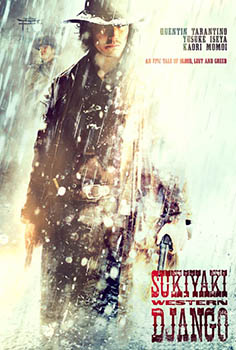Source: First Look Studios Official Movie Site (japan): Sukiyaki Western Django Official Movie Site (US): Sukiyaki Movie Special Thanks to JM Shop
SUKIYAKI WESTERN DJANGO
su•ki•ya•ki [soo-kee-yah-kee] n. A popular Japanese dish made with beef and usually containing soy sauce, bean curd, and greens, cooked in a single pot at the table. Simple ingredients cooked together without added broths to create a unique essence that is truly Japanese.
Genre: Action / Western Running Time: 121 minutes Completed: August 2007 Director: Takashi Miike Writers: Takashi Miike and Masaru Nakamura Cast: Hideaki Ito, Koichi Sato, Yusuke Iseya, Masanobu Ando, Takaaki Ishibashi, Yoshino Kimura, Teruyuki Kagawa, Masato Sakai, Shun Oguri, Quentin Tarantino, Kaori Momoi Studio: First Look Studios Now playing in New York; opens in Los Angeles on September 12 CAST Gunman: Hideaki Ito Kiyomori: Koichi Sato Yoshitsune: Yusuke Iseya Yoichi: Masanobu Ando Benkei: Takaaki Ishibashi Shizuka: Yoshino Kimura The Sheriff: Teruyuki Kagawa Shigemori : Masato Sakai Akira: Shun Oguri Ringo: Quentin Tarantino Ruriko: Kaori Momoi
CREW Director: Takashi Miike Screenplay: Masaru Nakamura & Takashi Miike Executive Producers: Toshiaki Nakazawa, Nobuyuki Tohya Co-Executive Producer: Dick N. Sano Producers: Hirotsugu Yoshida, Toshinori Yamaguchi Cinematographer: Toyomichi Kurita Music: Koji Endo Production Designer: Takashi Sasaki Lighting: Hideyuki Suzuki Sound: Jun Nakamura Editor: Taiji Shimamura Set Decorators: Takahisa Taguchi Costume Designer: Michiko Kitamura Sound Effects: Kenji Shibazaki First Assistant Director: Masato Tanno Production Manager: Hajime Tsubouchi Dialect Coach: Nadia Venesse Casting Director: Toshiie Tomida CGI Producer: Misako Saka
Auteur Directors Praise Takashi Miike
“Miike is one of the greatest directors living today.” ![]() -Quentin Tarantino, PULP FICTION, KILL BILL “Takashi Miike is one of the last true mavericks of world cinema. Miike films are pure punk rock: wild, creative, and absolutely no rules. He is single handedly keeping world cinema vibrant and alive. He is absolutely fearless, and few directors can make you laugh, cry and scream all at the same time. He is a true visionary, and does things that few other directors would ever dare do. There has never been anyone like him, and I am quite certain there will never be another one. He is one of a kind.”
-Quentin Tarantino, PULP FICTION, KILL BILL “Takashi Miike is one of the last true mavericks of world cinema. Miike films are pure punk rock: wild, creative, and absolutely no rules. He is single handedly keeping world cinema vibrant and alive. He is absolutely fearless, and few directors can make you laugh, cry and scream all at the same time. He is a true visionary, and does things that few other directors would ever dare do. There has never been anyone like him, and I am quite certain there will never be another one. He is one of a kind.” ![]() -Eli Roth, HOSTEL, CABIN FEVER Takashi Miike is the only heir apparent to the true midnight movie sensibility. His films are always disturbing, always personal and always guaranteed to push the limits in one way or another. The ultimate anarchist / artist, Miike paints disturbing and enduring landscapes with blood. His own and others. Beware."
-Eli Roth, HOSTEL, CABIN FEVER Takashi Miike is the only heir apparent to the true midnight movie sensibility. His films are always disturbing, always personal and always guaranteed to push the limits in one way or another. The ultimate anarchist / artist, Miike paints disturbing and enduring landscapes with blood. His own and others. Beware." ![]() -Guillermo del Toro, PAN`S LABYRINTH, HELLBOY 1 & 2
-Guillermo del Toro, PAN`S LABYRINTH, HELLBOY 1 & 2
Synopsis
 A Wandering Gunman (Hideaki Ito) duels with Yoshitsune Minamoto (Yusuke Iseya) in SUKIYAKI WESTERN DJANGO. © 2007
A Wandering Gunman (Hideaki Ito) duels with Yoshitsune Minamoto (Yusuke Iseya) in SUKIYAKI WESTERN DJANGO. © 2007 Famed Japanese auteur Takashi Miike, best known for cult classics AUDITION, ICHI THE KILLER, and THE CITY OF LOST SOULS, redefines the spaghetti Western with SUKIYAKI WESTERN DJANGO, a tale written in blood. Two clans, the white, Genji clan, led by Yoshitsune, and the red, Heike clan, led by Kiyomori, battle for a legendary treasure hidden in a desolate mountain town. One day, a lone gunman, burdened with deep emotional scars but blessed with incredible shooting skills, drifts into town. Two clans try to woo the lone gunman to their side, but he has ulterior motives. Dirty tricks, betrayal, desire and love collide as the situation erupts into a final, explosive showdown. Quentin Tarantino also stars.
Background
Sergio Corbucci’s 1966 cult masterpiece DJANGO popularized the subgenre of spaghetti westerns. In SUKIYAKI WESTERN DJANGO, Takashi Miike is paying homage to the spaghetti western, or “macaroni western,” as they are known in Japan. Miike follows a distinguished line of filmmakers, animators, artists, musicians and videogame makers that incorporate the aesthetics, plot, and iconography of Sergio Corbucci‘s DJANGO into their works.
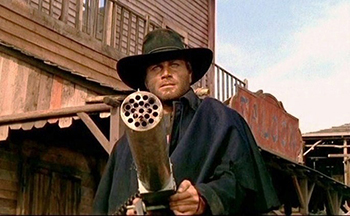 Django (Franco Nero) with his machine gun in Sergio Corbucci’s 1966 western DJANGO. © 1966 B.R.C. Produzione, Tecisa
Django (Franco Nero) with his machine gun in Sergio Corbucci’s 1966 western DJANGO. © 1966 B.R.C. Produzione, TecisaStrongly disliked by the Italian censors, the grotesquely violent DJANGO has been made infamous for the graphic imagery of the Mexican leader cutting the ear off of one of Major Jackson’s men and through the highly iconic act of a gun runner concealing a machine gun in a coffin. Like his Italian processor, Quentin Tarantino’s notoriously violent ‘ear cutting’ scene in RESERVOIR DOGS (1992) spurred a great deal of controversy amongst the censors. But to fans of both Corbucci and Tarantino, this scene is admired not only for its fluid, minimalist cinematography, a characteristic technique of the spaghetti western genre, but also for the strong emotional reactions that the scene evokes. The coffin used in Corbucci’s DJANGO to transport the machine gun has gained iconographic status because its prevalence in other works. It is thought that Robert Rodriguez, an avid spaghetti western fan along with Tarantino, is referencing Django in his film EL MARIACHI (1992) by having his main character carry a guitar case with weapons in it. In SUKIYAKI WESTERN DJANGO, Miike honors the dark, mysterious symbolism of the coffin through the dramatic battle that ensues between the Gengi and the Heike Clans when a wagon heist goes array. In the scene, the Gengi Clan realizes that the coffin being transported is a disguise for a secret and dangerous weapon. Other mainstream references to Corbucci’s DJANGO coffin are in the television series COWBOY BEEBOP, and in the videogames and anime series GUNGRAVE, BOTKAI and RED DEAD REVOLVER. The referencing of Corbucci’s renowned work in various films, television series, and video games demonstrate how loved and powerful his spaghetti western stylistics have become.
Takashi Miike perfectly incorporates his own auteur techniques into SUKIYAKI WESTERN DJANGO while striving for an authentic adaptation of Corbucci’s masterpiece. Set during the Genpei clan wars of the 12th century, and shot entirely in English language, SUKIYAKI WESTERN DJANGO brings together a talented crew of individuals, including several of Miike’s previous collaborators. The crew includes award-winning Director of Photography, Toyomichi Kurita (Robert Altman’s COOKIE`S FORTUNE), and an all-star cast including Hideaki Ito (the Umizaru films), Koichi Sato (CREST OF BETRAYAL), Yusuke Iseya (CASSHERN), Masanobu Ando (BATTLE ROYALE), Takaaki Ishibashi (MAJOR LEAGUE I &II),Yoshino Kimura (THE SAMURAI I LOVED), Teruyuki Kagawa (DEVIL`S ON THE DOORSTEP), and Kaori Momoi (MEMOIRS OF A GEISHA) with a special appearance from filmmaker Quentin Tarantino. The talented cast coupled with the stunning cinematography by Kurita vividly brings to life this epic tale re-approached in the spaghetti western genre. Miike brings his viewers into the filmic world of the original DJANGO through their auditory experience. The original DJANGO score used in Miike’s SUKIYAKI WESTERN DJANGO provides a paradoxical effect to the bold Japanese aesthetics of the film. The word “spaghetti western” immediately brings to mind the melodies of Ennio Morricone. The original theme song for DJANGO has been arranged into a new theme tune for Miike’s film. In SUKIYAKI WESTERN DJANGO, Koji Endo has created a melancholic score that combines trumpets, ocarinas and whistling. With newly written Japanese lyrics, a haunting new version is sung by Saburo Kitajima, the veteran enka (Japanese blues) singer, known for his powerful kobushi (a vibrato-like vocal technique). Kitajima, who was cast as a gambler in Miike’s 1996 film JINJI NAKI YABOU, at first was shocked by Miike’s unconventional methods. For the film, Miike had unsparingly splashed the great singer/actor with artificial blood. Kitajima had mumbled “I’ve been acting for some twenty, thirty years and I never knew that artificial blood felt so cold!” Miike’s eccentric techniques left a strong impression on the blood soaked Kitajima and attracted him to become involved in SUKIYAKI WESTERN DJANGO. In this fascinating film, Miike not only utilizes his Japanese expertise but also calls upon his Japanese colleagues to make something truly magnificent.
About the Production
SUKIYAKI WESTERN DJANGO was filmed on a specially built outdoor set in Ishikura, Yamagata, deep in the mountains of Tsukiyama in Japan. A surreal set combining both a western theme and “Jidai-geki” (Japanese period dramas) emerged in the midst of Tsukiyama’s magnificent mountain scenery.
The logistical difficulties of the shoot made the production a constant struggle primarily due to the extreme weather conditions. The freezing fall nights of Tsukiyama were severe enough to freeze the food on the plates of the cast and crew. Tsukiyama is known for its snowy winters. However, during production they had an unusually warm winter that resulted in almost no snowfall. This presented additional challenges for the film’s art design. One of the toughest days on set, the crew had to hit the trail on foot at 2 a.m. in the morning in order to arrive at the location by 4 a.m. It was for the sunrise scene, shot in the caves of Zao. Walking in the darkness with only the lights of the lighting department to rely on, more than a few crew members were nearly lost in the mountains. Another memorable day in set required forty horses galloping away at full speed and coordinating a large number of extras. This complex of a stunt is rarely seen in recent Japanese productions. Miike found the usual calls of “Ready!” and “Action!” were not adequate to coordinate the action sequence, and he resorted to donning a ten-gallon hat, taking out a Smith & Wesson and firing a blank in the air instead. The unexpected sound of gunshot surprised the extras whose reactions were expertly captured on film by cinematographer Toyomichi Kurita. One could say that the ultimate thrill of the production was the “face-off in the wilderness of Shonai territory” between Miike, shooting his Smith & Wesson, and Kurita, shooting with his Arriflex ST<!
SUKIYAKI WESTERN DJANGO was shot entirely in English. As for his first English language film, MASTERS OF HORROR – IMPRINT, Miike created a unique atmosphere on set. The actors went through a month-long intensive language training under Nadia Venesse, the dialogue coach who has worked on many notable films such as CHOCOLAT and NORTH COUNTRY, and with Christian Storms, who translated the Japanese script into English. For Venesse and Storms, SUKIYAKI WESTERN DJANGO was their second collaboration with Miike following MASTERS OF HORROR – IMPRINT. Japanese star Koichi Sato’s comment on the experience was: “I realize now how effortlessly I’ve been making money all these years.” The actors not only had lessons in English but were required to learn horseback riding and gun slinging. The actress Kaori Momoi also had the additional challenge of working with flying wires and trampolines as the legendary fighter “Bloody Benton.” At one point her whole body was wrapped in plastic to protect her from the cold, which made even a simple somersault a challenging feat.
Crew: From Hollywood to Italy to Japan
Takashi Miike – Director Takashi Miike was born in Osaka on August 24, 1960. He graduated from Yokohama Housou Eiga Senmon Gakuin (now called the Japan Academy of Moving Images). In his early career, he worked under such directors as Shohei Imamura and Hideo Onchi. In 1991, he directed his first direct-to-video film, EYECATCH JUNCTION. He followed this with many direct-to-video films before making his debut as a theatrical film director in 1995 with DAISAN NO GOKUDO and SHINJUKU TRIAD SOCIETY.
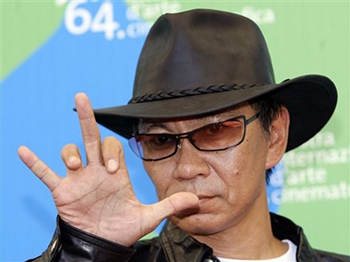 Director Takashi Miike promoting SUKIYAKI WESTERN DJANGO at the 64th Venice Film Festival. Photo © 2007 Associated Press
Director Takashi Miike promoting SUKIYAKI WESTERN DJANGO at the 64th Venice Film Festival. Photo © 2007 Associated PressRenowned for his innovative ideas and edgy directing style, Miike’s popularity boomed with FUDOH (1996), and was further fueled by BIRD PEOPLE OF CHINA (1998), and DEAD OR ALIVE (1999). In 1999, Miike created AUDITION, which quickly spread overseas. His unique visual style won both the KNF award and FIPRESCI prize at the 29th Rotterdam International Film Festival. He also ranked as the tenth “most promising film directors” chosen by TIME magazine. Since then, Takashi Miike, one of the most prolific directors in Japan, directed a list of films every year ranging from “gokudo” films to musicals including: THE CITY OF LOST SOULS (2000), ICHI THE KILLER (2001), THE HAPPINESS OF THE KATAKURIS (2001), GRAVEYARD OF HONOR (2002) and ZEBRAMAN (2003). In 2003, GOZU screened at the Cannes International Film Festival, becoming the first ever made-for-video film to be selected as a Director’s Fortnight official selection. In 2004, he directed ONE MISSED CALL (2004). Also in 2004, he came out with IZO which competed in the official section at the Venice International Film Festival. In 2005, he made THE GREAT YOKAI WAR and A BIG BANG LOVE: JUVENILE, which was screened in the Berlin International Film Festival’s Panorama section. His first English language horror feature, MASTERS OF HORROR – IMPRINT, was banned in the U.S. for its unexpectedly disturbing scenes. His upcoming film slate is full of exciting projects including: BISHONEN and YATTAAMAN (Spring 2009). In addition to directing, Miike has also starred in numerous films including KENKA NO HANAMICHI (1996) and AGITATOR, which he also directed, KYOUFU!! NAMAMUSHI YAKATA NO SAN-SHIMAI (1997 directed by Takeshi Miyasaka) and LAST LIFE IN THE UNIVERSE (2003 directed by Pen-Ek Ratanaluang), THE NEIGHBOR NO. THIRTEEN (2005 directed by Yasuo Inoue) and HOSTEL (2006 directed by Eli Roth). Quentin Tarantino, who executive produced HOSTEL, makes an appearance in SUKIYAKI WESTERN DJANGO, which was an exchange of friendship between the two film geniuses. Filmography
1991 EYECATCH JUNCTION (Toppu! Minipato Tai - Aikyachi Jankshon) [video]; LADY HUNTER (Redi Hanta - Koroshi no Pureryudo) [video] 1992 LAST RUN (Rasuto Run - Ai to Uragiri no Hyaku-oku Yen) [TV]; A HUMAN MURDER WEAPON (Ningen Kyoki - Ai to Ikari no Ringu) [video] 1993 BODYGUARD KIBA (Bodigado Kiba) [video]; ORETACHI WA TENSHI JA NAI [video];ORETACHI WA TENSHI JA NAI 2 [video] 1994 BODYGUARD KIBA 2 (Bodigado Kiba 2 - Shura no Mokushiroku 2) [video]; SHINJUKU OUTLAW (Shinjuku Autoro) [video] 1995 BODYGUARD KIBA 3 (Bodigado Kiba 3 - Shura no Mokushiroku 2) [video]; DAISAN NO GOKUDO [video]; NANIWA YUKYODEN [video]; SHINJUKU TRIAD SOCIETY (Shinjuku Kuroshakai - China Mafia Senso) 1996 SHIN DAISAN NO GOKUDO: BOPPATSU KANSAI GOKUDO UOZU!! [video]; SHIN DAISAN NO GOKUDO 2 [video]; JINJI NAKI YABO [video]; PEANUTS (Pinatsu - Rakkasei) [video]; KENKA NO HANAMICHI - OSAKA SAIKYO DENSETSU [video]; FUDOH: THE NEW GENERATION (Gokudo Sengokushi Fudo) 1997 JINJI NAKI YABO 2 [video]; YOUNG THUGS: INNOCENT BLOOD (Kishiwada Shonen Gurentai - Chikemuri Junjo Hen); RAINY DOG (Gokudo Kuroshakai - Reini Doggu); FULL METAL YAKUZA (Furu Metaru Gokudo) [video] 1998 BIRD PEOPLE OF CHINA (Chugoku no Chojin); ANDROMEDIA; BLUES HARP; YOUNG THUGS: NOSTALGIA (Kishiwada Shonen Gurentai - Bokyo Hen); ZUIKETSU GENSO - TONKARARIN YUME DEBSETSU [short] 1999 TENNEN SHOJO MANN [TV series, 3 episodes]; LEY LINES (Nihon Kuroshakai – Ley Lines); SILVER [video]; SALARYMAN KINTARO (Sarariman Kintaro); TENNEN SHOJO MANN NEXT [TV series, 2 episodes]; DEAD OR ALIVE (DOA Deddo oa Araibu - Hanzaisha) 2000 KIKUCHI - JO MONOGATARI - SAKIMORI-TACU NO UTA [short]; AUDITION; MPD-PSYCHO (Taju Jinkaku Tantei Saiko) [TV series, 6 episodes]; THE CITY OF LOST SOULS (Hyoryugai); DEAD OR ALIVE 2 (Deddo oa Aribu 2 - Tobosha); THE MAKING OF GEMINI (Tsukamoto Shinya ga Rampo Suru) [video] 2001 VISITOR Q; FAMILY; THE GUYS FROM PARADISE (Tengoku Kara Kita Otoko Tachi); ICHI THE KILLER (Koroshiya 1) 2002 DEAD OR ALIVE: FINAL (Deddo oa Aribu Final); THE HAPPINESS OF THE KATAKURIS (Onna Kunishu Ikki; Katakurike no Kofuku); AGITATOR (Araburu Tamashii Tachi); SABU [TV]; GRAVEYARD OF HONOR (Shin Jingi no Hakaba); GO! GO! FUSHIMI JET [music video]; SHANGRI-LA (Kinyu Hametsu Nippon – Togenkyo no Hitobito); DEADLY OUTLAW: REKKA (Jitsuroku – Ando Noboru Kyodo-Den: Rekka); THE GUNDOGS [music video]; PART TIME TANTEI [TV] 2003 KOI NO JERRIFISSHU [music video]; THE MAN IN WHITE (Yurusarezaru Mono); KIKOKU [video]; GOZU (Gokudo Kyofu Daigekijo - Gozu); THE NEGOTIATOR (Koshonin) 2004 ONE MISSED CALL (Chakushin Ari); ZEBRAMAN; PART TIME TANTEI 2 [TV]; THREE EXTREMES (Saam gaang yi); IZO; DEMON POND (Yashagaike) [stage] 2005 ULTRAMAN MAX (Uutoraman Makkusu) [TV series, 2 episodes]; THE GREAT YOKAI WAR (Yokai Daisenso) 2006 A BIG BANG LOVE: JUVENILE (46-okunen no koi); WARU; IMPRINT episode from MASTERS OF HORROR [TV]; WARU – KANKETSUHEN; SUN SCARRED (Taiyo no kizu); LIKE A DRAGON (Ryu ga gotoku: gekijo-ban) 2007 SUKIYAKI WESTERN DJANGO; CROWS ZERO Masaru Nakamura – Co-Writer Masaru Nakamura most recently wrote the smash hit DORORO. Nakamura’s credits include many of Miike films such as BIRD PEOPLE OF CHINA, DEAD OR ALIVE 2, and A BIG BANG LOVE: JUVENILE. Toyomichi Kurita – Director of Photography Toyomichi Kurita, who worked as a camera operator for the late Robert Altman (COOKIE`S FORTUNE) and his protégé Alan Rudolf. This is his second project with the Miike team following MASTERS OF HORROR – IMPRINT. Using his CINESCO super 35mm film, Kurita has created an incredibly beautiful but edgy look for this film. Michiko Kitamura – Costume Designer Costume Designer, Michiko Kitamura, created the wacky and ultimately very muddy costumes. She has collaborated with the Miike team on numerous projects including THE GREAT YOKAI WAR and MASTERS OF HORROR – IMPRINT. Takashi Sasaki – Production Designer Production designer, Takashi Sasaki, is also a regular member of the Miike team and previously worked on ICHI THE KILLER and UTSUKUSII YORU, ZANKOKUNA ASA (box), among others. Deep in the mountains of Shounai, Yamagata, Sasaki built an extraordinarily set for the film. Sasaki was previously praised by Quentin Tarantino for creating the Japanese set for KILL BILL. Rounding out this outstanding crew, are the other regular members of the Miike team: Misako Saka, the CGI producer, Yuichi Matsui, the special make-up/molding artist and editor, Taiji Shimamura.
Cast
A Wandering Gunman (Hideaki Ito) An emotionally scarred, high plains drifter who rides a black horse. He slings two pistols at lightning speed. This gun-for-hire shoots an arrow in mid-air.
Ito was born on August 3, 1975 in Gifu prefecture. He started his acting career in 1997 appearing in the TV drama, DESSAN. Since then, he has starred in films such as HIMITSU (1999), PYROKINESIS (2000), BLISTER (2000), LOVE SONG (2000) and PRINCESS BLADE (2001). In 2001, he reunited with director Yojiro Takita in ONMIYOJI and played the role of Hiromasa Minamoto opposite Mansai Nomura. Grossing 3.2 billion yen, the film became the top grossing Japanese live action movie of the year. In 2003, the sequel ONMIYOJI 2 established Ito as one of Japan’s top movie stars. In 2004, he played the role of Daisuke Senzaki, the Japanense Coast Guard rescue diver, in the blockbuster UMIZARU directed by Eiichiro Hasumi. UMIZARU was made into a TV drama series the next year, which was followed by LIMIT OF LOVE: UMIZARU in 2006 and became a three part film and TV project. LIMIT OF LOVE: UMIZARU grossed 7.1 billion yen at the box office and became the number one Japanese live action film of the year. Other credits include A HEARTFUL OF LOVE (2005) for director Akihiko Shioda. The Hard-Nosed Tyrant - Kiyomori Taira (Koichi Sato) Kiyomori, a.k.a. Henry, leads the Heike gang dressed in red. Clad in European armor, he sprays the village with shots from his Gatlin gun screaming “I won’t die until we win!”
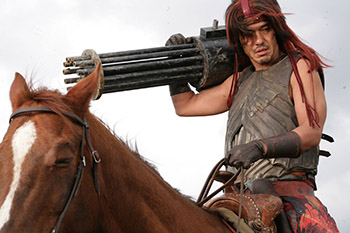 Koichi Sato as Kiyomori Taira, leader of the Red Heike gang. Photo courtesy of New York Asian Film Festival. © 2007
Koichi Sato as Kiyomori Taira, leader of the Red Heike gang. Photo courtesy of New York Asian Film Festival. © 2007 Koichi Sato was born in Tokyo and started his acting career in 1980 with the television drama ZOKU ZOKU-JIKEN. The following year, he received the Best New Actor Award at the Blue Ribbon Awards for his performance in SEISHUN NO MON (1981). Since then, he has starred in numerous films including GYOEI NO MURE (1983) and DUN HUANG (1988). In 1994, he received multiple awards including the Japanese Academy’s Best Actor Awards for CREST OF BETRAYAL (Chushingura Gaiden Yotwuya Kaidan) and TOKAREFU. His other credits include Junji Sakamoto’s KT (2002), MIBU GISHINDEN (2002), SAMURAI RESURRECTION (Makai Tenshou, 2003), AEGIS (Bokoku No Igis, 2005), and UCHOTEN HOTEL (2006), directed by Kouki Mitani. In 2006, he won the Best Actor award at the 18th Tokyo International Film Festival and the 60th Mainichi Film Concours for WHAT THE SNOW BRINGS (Yuki Ni Negau Koto). The Proud, Merciless Warrior- Yoshitsune Minamoto (Yusuke Iseya) The commander of the white clad Genji gang aspires to live a “mononofu” life of fighting instead of a philosophical “samurai” existence. Cruel and heartless, his drawn sword craves a truly worthy opponent.
Yusuke Iseya was born on May 29, 1976 in Tokyo, Japan. In 1998, he made his big screen debut in WONDERFUL LIFE, directed by Hirokazu Koreeda. The same year, he attended NYU and studied filmmaking. In 1998, he had his first leading role in KINPATSU NO SOGEN, and he followed it with films such as DISTANCE (2001) and GAICHUU (2002). In 2003, he made his directorial debut with KAKUTO, which he also wrote and starred in. The film was screened as an official selection at the Rotterdam International Film Festival and received rave reviews. In 2004, he starred in CASSHERN, directed by Kazuaki Kiriya, which became a huge hit. 2006 was a prolific year for Iseya, who starred in several features: MEMORIES OF MATSUKO (Kiraware Matsuko No Isshou), HONEY & CLOVER (Hachimitsu To Clover) and SEA WITHOUT EXIT (Deguchi No Nai Umi) among others. In 2006, he starred in WHAT THE SNOW BRINGS (2006), directed by Kichitaro Negishi, opposite Koichi Sato. This role resulted in Iseya receiving the 1st INVIATION Award’s Actor of the Year at the Tokyo International Film Festival. He recently completed the features DEATHFIX (Zukan Ni Nottenai Mushi), DENSENKA, and CLOSED NOTE.
A Crazed Incarnation Of Death – Yoichi (Masanobu Ando) As the craziest Genji of the clan, Yoichi magnificently wields his deadly bowgun. Setting his sight on his prey, Yoichi’s eyes dazzle before he kills. Ando was born on May 19, 1975. In 1996, he made his screen debut with a leading role in Takeshi Kitano’s KIDS RETURN, which won him numerous Best New Actor Awards including the Golden Arrow Award. He has starred in a wide variety of films including BATTLE ROYALE (2000), RED SHADOW ~ AKAKAGE (2001), DRIVE (2002), KARAOKE TERROR (Showa Kayou Daizenshu, 2003), 69 SIXTY NINE (2004), and AEGIS (2005). In 2006, he starred in Kazuyoshi Kumakiri’s SEISHUN KINZOKU BATTO, Hitoshi Yazaki’s STRAWBERRY SHORTCAKES and his first collaboration with Takashi Miike, A BIG BANG LOVE: JUVENILE. Most recently he starred in NIGHTMARE DETECTIVE (Akumu Tantei) and SAKURAN. A Tender Hearted Hero – Benkei (Takaaki Ishibashi) Leave the firepower to Benkei who provides the dynamite, the rifles and the machine guns. He is Yoshitsune’s right-hand man and the gang’s hooligan. Ishibashi was born on October 22, 1961 in Tokyo. In 1980, he teamed up with Noritake Kinashi, his classmate at Teikyo Senior High School, and won the grand prize in the NTV’s OWARAI STAR TANJO. Since then, the comedic duo known as “Tunnels“ has starred in countless TV variety shows. In addition to a successful career as comedians, they received the Nihon Kayo Taisho award as musical artists and continue to act in dramatic features. They made their feature film debut with starring roles in Yoshimitsu Morita’s SOROBAN ZUKU (1986). As a solo artist, Ishibashi, starred in the Hollywood feature MAJOR LEAGUE II (1994), and the sequel MAJOR LEAGUE: BACK TO THE MINORS (1998). He also starred in STEAL BIG, STEAL LITTLE (1997) with Andy Garcia. A Flower with a Sad Fate – Shizuka (Yoshino Kimura) A Genji herself, the man she loved and married was a Heike. When her husband was murdered by Kiyomori, she vowed revenge for her son, Heihachi.
Kimura was born on April 10, 1976 in Tokyo but spent her junior high school years in New York. Her career debut was a leading role in the television drama GENKI WO AGERU ~ KYUMEI KYUKYUI MONOGATARI (1996). In 1997, she made her big screen debut with Yoshimitsu Morita’s Shitsurakuen. Her performance received rave reviews, which won her the Japanese Academy Award’s New Actors Award. Her credits include MOHOU-HAN (2002), LIKE ASHURA (Ashura No Gotoku, 2003), FUNE WO ORITARA NO SHIMA (2002), and THE SAMURAI I LOVED (Semishigure, 2005) for which she won the Best Actress Award at the Japanese Academy Awards. She has also appeared in many popular television drama series, on stage and in numerous commercials. In 2006, she starred in NEZU NO BAN and SAKURAN. She most recently starred in DREAM CRUISE (2007), directed by Norio Tsuruta. A Man Frightened Of Authority and Himself – Sheriff (Teruyuki Kagawa) Walking a fine line between the Genji and the Heike gangs, this opportunistic sheriff plays both sides of his personality. Kagawa was born in Tokyo on December 7, 1965. After a career debut with NHK’s historical drama series KASUGA NO TSUBONE in 1989, he went on to has star in films such as BOY`S CHOIR (Dokuritsu Shonen Gasshodan, 2000), for which he won the Best Supporting Actor Award at the Nikkan Sports Film Awards. He also starred in NUAN (2003), directed by Jianqi Huo, which won the Grand Prize and for which he won the Best Actor Award at the Tokyo International Film Festival. Last year, he won the Best Actor award for his role in Miwa Nishikawa’s YURERU. His recent film credits include KISARAGI (2007) and TSUKIGAMI (2007). He will next star in the NHK special drama SAKA NO UE NO KUMO. An accomplished stage actor, Kagawa is also a successful author and winner of the Kinema Junpo Readers Choice Awards.
The Brave Leader Whose Code Is Loyalty - Shigemori Taira (Masato Sakai) Shigemori always serves as a shield to protect Kiyomori, the Heike gang boss but he’s a little too skinny for Kiyomori’s own good! Masato Sakai was born on October 14, 1973. He started his career in 1992 by joining the Gekidan Tokyo Orange of Waseda University’s drama workshop and starred in Eriko Watanabe’s ZENMAI (1998), Kouki Mitani’s VAMP SHOW (2001) and MOFUKO NO NIAU ELECTRA (2004). Recently, he starred in UWASA NO OTOKO, directed by Keralino Sandorovich, at the Parco Theater. He has also worked extensively on television, starring in the NHK morning drama series AUDREY (2000), NHK historical dramas SHINSENGUMI! (2004), IZUMO NO OKUNI (2006), the Fuji TV drama series DR. KYOTO SHINRYOJO 2006 and “HIMITSU NO HANAZONO (2007), and the TBS drama “KODOKU NO KAKE ~ ITOSHIKI HITO YO” among others. Since making his big screen debut in 2000 with KASEI NO WAGAYA, directed by Taku Oshima, he has starred in many features including Isao Yukisada’s SUNFLOWER (Himawari, 2000), HARIKOMI (2001), KOKONI IRUKOTO (2001), MIBU GISHINDEN (2003), HONEY & CLOVER (2006) and KABEOTOKO (2006). A Tragic Man of Justice – Akira (Shun Oguri) Hot-blooded Akira, the son of a Heike family descendent Ruriko, husband of Shizuka and father of Heihachi, aspires to create peace in the village.
Shun Oguri was born in Tokyo on December 26, 1982. He started acting as an extra in film when he was in the sixth grade. He first gained attention as a deaf mute boy in a TBS drama series SUMMER SNOW. In 2001, he played his first lead role in an NTV drama series CHERRY, which he followed with his first leading role in a feature film, JUNJI HANADOU. His popularity soared in 2003 with AZUMI, directed by Ryuhei Kitamura and Robokon, directed by Tomoyuki Furumaya. As one of the leading actors of his generation, he works extensively in film, television and theatre. His other credits include THE NEIGHBOR NO. THIRTEEN (2005), directed by Yasuo Inoue, which won the Critics Award at the Yubari International Fantastic Film Festival, and KISARAGI (2007) directed by Koichi Sato. His stage credits include Yukio Ninagawa directed “Hamlet” (2003) and “Taitasuandoronikasu” (2006). As one of the regular members of the Ninagawa team, he will appear in Ninagawa’s “Karigura” at the Theater Cocoon in November. His next upcoming feature is CROWS ZERO II directed by Takashi Miike. A Mythic Gunslinger – Piringo (Quentin Tarantino) This proud and arrogant homeless wanderer dressed in a poncho has a deep knowledge of the oriental spirit. Going by the name Piringo, this man loves sala flowers (women) and guns.
Quentin Tarantino was born on March 27, 1963, in Knoxville, Tennessee, but was raised in Los Angeles. After dropping out of high school, he held a day job at a video rental store while taking acting classes. He appeared in TV and local theater. In 1991, he directed his first feature RESERVOIR DOGS, in which he also starred. RESERVOIR DOGS garnered worldwide acclaim including the Critics Award at Yubari International Fantastic Film Festival. He followed this success with PULP FICTION (1994), for which he received the Palme d’Or at the Cannes International Film Festival. Other credits include FROM DUSK TILL DAWN (2006) and DESPERADO, directed by his friend Robert Rodriguez. Quentin continues to write, direct and act. His most recent directorial feature is DEATH PROOF, which is part of the part of the double feature GRINDHOUSE. A Kind Hearted Calamity Jane – Ruriko (Kaori Momoi) Ruriko, a descendant of the defeated Heike soldiers, was one of the early settlers in the village of Yuta. She runs a general store and takes care of her grandson Heihachi. But she hides a great secret - if there is killing to be done, Bloody Benten is your woman.
Kaori Momoi was born on April 8, 1952. She attended the British Royal Academy of Dance at the age of 12. After training at Bungakuza, she made her screen debut in 1971 with ARAKAJIME USHINAWARETA KOIBITOTACHIYA, directed by Soichiro Tawara. While becoming an icon of the new generation in Toshiya Fujita’s AKAI TORI NIGETA? (1973) and Tatsumi Kamishiro’s Seishun No Satetsu (1974), she won the Best Supporting Actress awards at the Japan Academy Awards and Kinema Junpo Awards for her performance in Yoji Yamada’s YELLOW HANDKERCHIEF (Shiawase No Kiiroi Hankachi, 1977). Since then, she has had an impressive career, winning many awards with such films as MO HOZJUE WA TSUKANAI, TOMORROW/Ashita, THE YEN FAMILY (Kimurake No Hitobito), and TOKYO LULLABY (Tokyo Yakyoku). Internationally, Momoi also starred in Rob Marshall’s MEMOIRS OF A GEISHA(2005) and in the Russian feature SOLNTSE (2005), directed by Aleksandr Sokurov. In 2006 she wrote, directed and starred in FACES OF A FIGTREE (Ichijiku No Kao), which won the Netpak award at the Berlin International Film Festival. This film was screened in 12 countries as official selection and received international acclaim. Momoi is a unique and ageless actress who continues to influence women worldwide.
Interview with Takashi Miike
Question: You’re more of a “dragon generation” rather than a “macaroni western generation, aren’t you? Takashi Miike: “Yes. There weren’t many macaroni westerns in the theaters when I was growing up but they used to broadcast two to three of them every week on television… I can’t tell you how many times they aired ONE SILVER DOLLAR. My mother used to tell me to go to bed, but I usually stayed up and watched them with my parents. My father loved macaroni westerns and he used to buy me toy guns and pistols. My grandfather was a hunter and used to shoot birds with rifles. So the macaroni western was certainly very familiar to me. But having worked in the movie industry for a long time, I never thought that I would be making something like this as a Japanese film.” Q: Neither did we (laughs). How did it come about?
 Hideaki Ito, Takashi Miike, and Kaori Momoi at the 64th Venice Film Festival. Photo © 2007 Associated Press
Hideaki Ito, Takashi Miike, and Kaori Momoi at the 64th Venice Film Festival. Photo © 2007 Associated PressMiike: “Toshiaki Nakazawa, a producer at Sedic International, whom I had worked with on THE HAPPINESS OF THE KATAKURIS, asked me if there was any project that I wanted to do. That’s when the words ‘How about a sukiyaki western?’ fell out of my mouth. It’s what they call talking through one’s hat, I guess. But it wasn’t totally groundless. When I was a kid, I used to imagine myself growing up to be a wandering gunman. I don’t remember the specific stories but I was impressed with such things as the cool posture of the gunman, the intensity right before the shoot-out, and the dramatic effect of the music that starts after someone falls to the ground. Those kinds of things were imprinted on my mind. And I thought that anything a child can create in his imagination, surely a movie can bring to life.” “I think that any other producer would have just dismissed the idea with a laugh but Mr. Nakazawa didn’t. He said it was interesting and went along with the idea. Although he may have said “No” if I had suggested a Sushi Western” (laughs). Q: Was it Masaru Nakamura who linked that idea with the Tales of Heike? Miike: “As we watched and studied macaroni westerns, we realized that they were rooted in Japanese movies. And then we thought that the root of all Japanese movies is the Taira-Minamoto War. We started writing the script based on that concept. Masaru writes a very literary script, which I made into more of a screenplay by incorporating my ideas on how I would shoot on set.” Q: And this time you had it translated to English… Miike: “When you have so many leading men and women as in this movie, it’s a tough job just to give them satisfying answers to all their questions. So, I raised the hurdle a notch so that they’d be too busy to come up with any questions. I thought I could go ahead and quickly shoot the movie while they were struggling with their English (laughs).” “But their English is not an imitation of native speakers. Their accent is unique to the Japanese people. It would be interesting if English-language speakers think their Japanese English is cool and start imitating them, then I think we might change something! Japanese actors would be able to expand the scope of their careers. And for Japanese movies, surprising possibilities might result.
Q: Unexpected dividends, so to speak… Italy’s macaroni westerns and Hong Kong films were something of that sort, to start with, weren’t they? Did making MASTERS OF HORROR – IMPRINT in English lead you to this film? Miike: “Yes, it did. If I hadn’t made IMPRINT, I don’t think I would have come up with this idea of a sukiyaki western. Maybe not even the idea of making a western at all. Even if I had thought about it, I wouldn’t have been able to pitch it to the producer. The fact that an American producer had said “Yes” to IMPRINT encouraged me.... Although I don’t personally understand English, it was a big thing for me to know that I have people like Nadia Venesse, the dialogue coach from Hollywood and (Masahito) Tanno the assistant director who speaks it, to make up for my inadequacy. Having Toyomichi Kurita, who has worked extensively in Hollywood, also helped a great deal. My directions were the same as usual but when I looked at the result, I was amazed. It looked totally different from any of my films. That is a wonderful thing. You can change by collaborating with other people. That’s what makes filmmaking fun.” Q: I certainly felt the change. This film definitely has the same MIike vision but the quality of “blood” has changed, if you will. As a sukiyaki western, while keeping in mind the violence that is associated with director Takashi Miike (laughs), the blood ties from parent to child seem to have become thicker, which relates to you watching macaroni westerns with your father and to playing with your toy guns. Miike: (Laughs) If possible, I want to make this into a trilogy with “Sukiyaki Amazons” and “Sukiyaki Emmanuelle.” I think it would be pretty cool. Quentin said he will invest in it if I would cast him as a sex slave who’s beaten up by Chiaki Kuriyama (laughs again).
ABOUT FIRST LOOK STUDIOS
First Look Studios, a leading independent supplier in the entertainment marketplace, acquires, markets and distributes feature films, television series and specialty programming. . First Look owns a vast home entertainment library, consisting of over 1400 titles. First Look has enjoyed recent success with home entertainment releases such as THE CONTRACT, DAY OF THE DEAD and PARIS JE T’AIME, the television series such as THE COSBY SHOW, CYBILL and GRACE UNDER FIRE and the extremely successful UFC fights and GHOST HUNTERS series. First Look Studios’ upcoming theatrical releases include TRANSSIBERIAN and SUKIYAKI WESTERN DJANGO.
Source: First Look Studios Official Movie Site (japan): Sukiyaki Western Django Official Movie Site (US): Sukiyaki Movie Special Thanks to JM Shop
SUKIYAKI WESTERN DJANGO
su•ki•ya•ki [soo-kee-yah-kee] n. A popular Japanese dish made with beef and usually containing soy sauce, bean curd, and greens, cooked in a single pot at the table. Simple ingredients cooked together without added broths to create a unique essence that is truly Japanese.
Genre: Action / Western Running Time: 121 minutes Completed: August 2007 Director: Takashi Miike Writers: Takashi Miike and Masaru Nakamura Cast: Hideaki Ito, Koichi Sato, Yusuke Iseya, Masanobu Ando, Takaaki Ishibashi, Yoshino Kimura, Teruyuki Kagawa, Masato Sakai, Shun Oguri, Quentin Tarantino, Kaori Momoi Studio: First Look Studios Now playing in New York; opens in Los Angeles on September 12 CAST Gunman: Hideaki Ito Kiyomori: Koichi Sato Yoshitsune: Yusuke Iseya Yoichi: Masanobu Ando Benkei: Takaaki Ishibashi Shizuka: Yoshino Kimura The Sheriff: Teruyuki Kagawa Shigemori : Masato Sakai Akira: Shun Oguri Ringo: Quentin Tarantino Ruriko: Kaori Momoi
CREW Director: Takashi Miike Screenplay: Masaru Nakamura & Takashi Miike Executive Producers: Toshiaki Nakazawa, Nobuyuki Tohya Co-Executive Producer: Dick N. Sano Producers: Hirotsugu Yoshida, Toshinori Yamaguchi Cinematographer: Toyomichi Kurita Music: Koji Endo Production Designer: Takashi Sasaki Lighting: Hideyuki Suzuki Sound: Jun Nakamura Editor: Taiji Shimamura Set Decorators: Takahisa Taguchi Costume Designer: Michiko Kitamura Sound Effects: Kenji Shibazaki First Assistant Director: Masato Tanno Production Manager: Hajime Tsubouchi Dialect Coach: Nadia Venesse Casting Director: Toshiie Tomida CGI Producer: Misako Saka
Auteur Directors Praise Takashi Miike
“Miike is one of the greatest directors living today.” ![]() -Quentin Tarantino, PULP FICTION, KILL BILL “Takashi Miike is one of the last true mavericks of world cinema. Miike films are pure punk rock: wild, creative, and absolutely no rules. He is single handedly keeping world cinema vibrant and alive. He is absolutely fearless, and few directors can make you laugh, cry and scream all at the same time. He is a true visionary, and does things that few other directors would ever dare do. There has never been anyone like him, and I am quite certain there will never be another one. He is one of a kind.”
-Quentin Tarantino, PULP FICTION, KILL BILL “Takashi Miike is one of the last true mavericks of world cinema. Miike films are pure punk rock: wild, creative, and absolutely no rules. He is single handedly keeping world cinema vibrant and alive. He is absolutely fearless, and few directors can make you laugh, cry and scream all at the same time. He is a true visionary, and does things that few other directors would ever dare do. There has never been anyone like him, and I am quite certain there will never be another one. He is one of a kind.” ![]() -Eli Roth, HOSTEL, CABIN FEVER Takashi Miike is the only heir apparent to the true midnight movie sensibility. His films are always disturbing, always personal and always guaranteed to push the limits in one way or another. The ultimate anarchist / artist, Miike paints disturbing and enduring landscapes with blood. His own and others. Beware."
-Eli Roth, HOSTEL, CABIN FEVER Takashi Miike is the only heir apparent to the true midnight movie sensibility. His films are always disturbing, always personal and always guaranteed to push the limits in one way or another. The ultimate anarchist / artist, Miike paints disturbing and enduring landscapes with blood. His own and others. Beware." ![]() -Guillermo del Toro, PAN`S LABYRINTH, HELLBOY 1 & 2
-Guillermo del Toro, PAN`S LABYRINTH, HELLBOY 1 & 2
Synopsis
 A Wandering Gunman (Hideaki Ito) duels with Yoshitsune Minamoto (Yusuke Iseya) in SUKIYAKI WESTERN DJANGO. © 2007
A Wandering Gunman (Hideaki Ito) duels with Yoshitsune Minamoto (Yusuke Iseya) in SUKIYAKI WESTERN DJANGO. © 2007 Famed Japanese auteur Takashi Miike, best known for cult classics AUDITION, ICHI THE KILLER, and THE CITY OF LOST SOULS, redefines the spaghetti Western with SUKIYAKI WESTERN DJANGO, a tale written in blood. Two clans, the white, Genji clan, led by Yoshitsune, and the red, Heike clan, led by Kiyomori, battle for a legendary treasure hidden in a desolate mountain town. One day, a lone gunman, burdened with deep emotional scars but blessed with incredible shooting skills, drifts into town. Two clans try to woo the lone gunman to their side, but he has ulterior motives. Dirty tricks, betrayal, desire and love collide as the situation erupts into a final, explosive showdown. Quentin Tarantino also stars.
Background
Sergio Corbucci’s 1966 cult masterpiece DJANGO popularized the subgenre of spaghetti westerns. In SUKIYAKI WESTERN DJANGO, Takashi Miike is paying homage to the spaghetti western, or “macaroni western,” as they are known in Japan. Miike follows a distinguished line of filmmakers, animators, artists, musicians and videogame makers that incorporate the aesthetics, plot, and iconography of Sergio Corbucci‘s DJANGO into their works.
 Django (Franco Nero) with his machine gun in Sergio Corbucci’s 1966 western DJANGO. © 1966 B.R.C. Produzione, Tecisa
Django (Franco Nero) with his machine gun in Sergio Corbucci’s 1966 western DJANGO. © 1966 B.R.C. Produzione, TecisaStrongly disliked by the Italian censors, the grotesquely violent DJANGO has been made infamous for the graphic imagery of the Mexican leader cutting the ear off of one of Major Jackson’s men and through the highly iconic act of a gun runner concealing a machine gun in a coffin. Like his Italian processor, Quentin Tarantino’s notoriously violent ‘ear cutting’ scene in RESERVOIR DOGS (1992) spurred a great deal of controversy amongst the censors. But to fans of both Corbucci and Tarantino, this scene is admired not only for its fluid, minimalist cinematography, a characteristic technique of the spaghetti western genre, but also for the strong emotional reactions that the scene evokes. The coffin used in Corbucci’s DJANGO to transport the machine gun has gained iconographic status because its prevalence in other works. It is thought that Robert Rodriguez, an avid spaghetti western fan along with Tarantino, is referencing Django in his film EL MARIACHI (1992) by having his main character carry a guitar case with weapons in it. In SUKIYAKI WESTERN DJANGO, Miike honors the dark, mysterious symbolism of the coffin through the dramatic battle that ensues between the Gengi and the Heike Clans when a wagon heist goes array. In the scene, the Gengi Clan realizes that the coffin being transported is a disguise for a secret and dangerous weapon. Other mainstream references to Corbucci’s DJANGO coffin are in the television series COWBOY BEEBOP, and in the videogames and anime series GUNGRAVE, BOTKAI and RED DEAD REVOLVER. The referencing of Corbucci’s renowned work in various films, television series, and video games demonstrate how loved and powerful his spaghetti western stylistics have become.
Takashi Miike perfectly incorporates his own auteur techniques into SUKIYAKI WESTERN DJANGO while striving for an authentic adaptation of Corbucci’s masterpiece. Set during the Genpei clan wars of the 12th century, and shot entirely in English language, SUKIYAKI WESTERN DJANGO brings together a talented crew of individuals, including several of Miike’s previous collaborators. The crew includes award-winning Director of Photography, Toyomichi Kurita (Robert Altman’s COOKIE`S FORTUNE), and an all-star cast including Hideaki Ito (the Umizaru films), Koichi Sato (CREST OF BETRAYAL), Yusuke Iseya (CASSHERN), Masanobu Ando (BATTLE ROYALE), Takaaki Ishibashi (MAJOR LEAGUE I &II),Yoshino Kimura (THE SAMURAI I LOVED), Teruyuki Kagawa (DEVIL`S ON THE DOORSTEP), and Kaori Momoi (MEMOIRS OF A GEISHA) with a special appearance from filmmaker Quentin Tarantino. The talented cast coupled with the stunning cinematography by Kurita vividly brings to life this epic tale re-approached in the spaghetti western genre. Miike brings his viewers into the filmic world of the original DJANGO through their auditory experience. The original DJANGO score used in Miike’s SUKIYAKI WESTERN DJANGO provides a paradoxical effect to the bold Japanese aesthetics of the film. The word “spaghetti western” immediately brings to mind the melodies of Ennio Morricone. The original theme song for DJANGO has been arranged into a new theme tune for Miike’s film. In SUKIYAKI WESTERN DJANGO, Koji Endo has created a melancholic score that combines trumpets, ocarinas and whistling. With newly written Japanese lyrics, a haunting new version is sung by Saburo Kitajima, the veteran enka (Japanese blues) singer, known for his powerful kobushi (a vibrato-like vocal technique). Kitajima, who was cast as a gambler in Miike’s 1996 film JINJI NAKI YABOU, at first was shocked by Miike’s unconventional methods. For the film, Miike had unsparingly splashed the great singer/actor with artificial blood. Kitajima had mumbled “I’ve been acting for some twenty, thirty years and I never knew that artificial blood felt so cold!” Miike’s eccentric techniques left a strong impression on the blood soaked Kitajima and attracted him to become involved in SUKIYAKI WESTERN DJANGO. In this fascinating film, Miike not only utilizes his Japanese expertise but also calls upon his Japanese colleagues to make something truly magnificent.
About the Production
SUKIYAKI WESTERN DJANGO was filmed on a specially built outdoor set in Ishikura, Yamagata, deep in the mountains of Tsukiyama in Japan. A surreal set combining both a western theme and “Jidai-geki” (Japanese period dramas) emerged in the midst of Tsukiyama’s magnificent mountain scenery.
The logistical difficulties of the shoot made the production a constant struggle primarily due to the extreme weather conditions. The freezing fall nights of Tsukiyama were severe enough to freeze the food on the plates of the cast and crew. Tsukiyama is known for its snowy winters. However, during production they had an unusually warm winter that resulted in almost no snowfall. This presented additional challenges for the film’s art design. One of the toughest days on set, the crew had to hit the trail on foot at 2 a.m. in the morning in order to arrive at the location by 4 a.m. It was for the sunrise scene, shot in the caves of Zao. Walking in the darkness with only the lights of the lighting department to rely on, more than a few crew members were nearly lost in the mountains. Another memorable day in set required forty horses galloping away at full speed and coordinating a large number of extras. This complex of a stunt is rarely seen in recent Japanese productions. Miike found the usual calls of “Ready!” and “Action!” were not adequate to coordinate the action sequence, and he resorted to donning a ten-gallon hat, taking out a Smith & Wesson and firing a blank in the air instead. The unexpected sound of gunshot surprised the extras whose reactions were expertly captured on film by cinematographer Toyomichi Kurita. One could say that the ultimate thrill of the production was the “face-off in the wilderness of Shonai territory” between Miike, shooting his Smith & Wesson, and Kurita, shooting with his Arriflex ST<!
SUKIYAKI WESTERN DJANGO was shot entirely in English. As for his first English language film, MASTERS OF HORROR – IMPRINT, Miike created a unique atmosphere on set. The actors went through a month-long intensive language training under Nadia Venesse, the dialogue coach who has worked on many notable films such as CHOCOLAT and NORTH COUNTRY, and with Christian Storms, who translated the Japanese script into English. For Venesse and Storms, SUKIYAKI WESTERN DJANGO was their second collaboration with Miike following MASTERS OF HORROR – IMPRINT. Japanese star Koichi Sato’s comment on the experience was: “I realize now how effortlessly I’ve been making money all these years.” The actors not only had lessons in English but were required to learn horseback riding and gun slinging. The actress Kaori Momoi also had the additional challenge of working with flying wires and trampolines as the legendary fighter “Bloody Benton.” At one point her whole body was wrapped in plastic to protect her from the cold, which made even a simple somersault a challenging feat.
Crew: From Hollywood to Italy to Japan
Takashi Miike – Director Takashi Miike was born in Osaka on August 24, 1960. He graduated from Yokohama Housou Eiga Senmon Gakuin (now called the Japan Academy of Moving Images). In his early career, he worked under such directors as Shohei Imamura and Hideo Onchi. In 1991, he directed his first direct-to-video film, EYECATCH JUNCTION. He followed this with many direct-to-video films before making his debut as a theatrical film director in 1995 with DAISAN NO GOKUDO and SHINJUKU TRIAD SOCIETY.
 Director Takashi Miike promoting SUKIYAKI WESTERN DJANGO at the 64th Venice Film Festival. Photo © 2007 Associated Press
Director Takashi Miike promoting SUKIYAKI WESTERN DJANGO at the 64th Venice Film Festival. Photo © 2007 Associated PressRenowned for his innovative ideas and edgy directing style, Miike’s popularity boomed with FUDOH (1996), and was further fueled by BIRD PEOPLE OF CHINA (1998), and DEAD OR ALIVE (1999). In 1999, Miike created AUDITION, which quickly spread overseas. His unique visual style won both the KNF award and FIPRESCI prize at the 29th Rotterdam International Film Festival. He also ranked as the tenth “most promising film directors” chosen by TIME magazine. Since then, Takashi Miike, one of the most prolific directors in Japan, directed a list of films every year ranging from “gokudo” films to musicals including: THE CITY OF LOST SOULS (2000), ICHI THE KILLER (2001), THE HAPPINESS OF THE KATAKURIS (2001), GRAVEYARD OF HONOR (2002) and ZEBRAMAN (2003). In 2003, GOZU screened at the Cannes International Film Festival, becoming the first ever made-for-video film to be selected as a Director’s Fortnight official selection. In 2004, he directed ONE MISSED CALL (2004). Also in 2004, he came out with IZO which competed in the official section at the Venice International Film Festival. In 2005, he made THE GREAT YOKAI WAR and A BIG BANG LOVE: JUVENILE, which was screened in the Berlin International Film Festival’s Panorama section. His first English language horror feature, MASTERS OF HORROR – IMPRINT, was banned in the U.S. for its unexpectedly disturbing scenes. His upcoming film slate is full of exciting projects including: BISHONEN and YATTAAMAN (Spring 2009). In addition to directing, Miike has also starred in numerous films including KENKA NO HANAMICHI (1996) and AGITATOR, which he also directed, KYOUFU!! NAMAMUSHI YAKATA NO SAN-SHIMAI (1997 directed by Takeshi Miyasaka) and LAST LIFE IN THE UNIVERSE (2003 directed by Pen-Ek Ratanaluang), THE NEIGHBOR NO. THIRTEEN (2005 directed by Yasuo Inoue) and HOSTEL (2006 directed by Eli Roth). Quentin Tarantino, who executive produced HOSTEL, makes an appearance in SUKIYAKI WESTERN DJANGO, which was an exchange of friendship between the two film geniuses. Filmography
1991 EYECATCH JUNCTION (Toppu! Minipato Tai - Aikyachi Jankshon) [video]; LADY HUNTER (Redi Hanta - Koroshi no Pureryudo) [video] 1992 LAST RUN (Rasuto Run - Ai to Uragiri no Hyaku-oku Yen) [TV]; A HUMAN MURDER WEAPON (Ningen Kyoki - Ai to Ikari no Ringu) [video] 1993 BODYGUARD KIBA (Bodigado Kiba) [video]; ORETACHI WA TENSHI JA NAI [video];ORETACHI WA TENSHI JA NAI 2 [video] 1994 BODYGUARD KIBA 2 (Bodigado Kiba 2 - Shura no Mokushiroku 2) [video]; SHINJUKU OUTLAW (Shinjuku Autoro) [video] 1995 BODYGUARD KIBA 3 (Bodigado Kiba 3 - Shura no Mokushiroku 2) [video]; DAISAN NO GOKUDO [video]; NANIWA YUKYODEN [video]; SHINJUKU TRIAD SOCIETY (Shinjuku Kuroshakai - China Mafia Senso) 1996 SHIN DAISAN NO GOKUDO: BOPPATSU KANSAI GOKUDO UOZU!! [video]; SHIN DAISAN NO GOKUDO 2 [video]; JINJI NAKI YABO [video]; PEANUTS (Pinatsu - Rakkasei) [video]; KENKA NO HANAMICHI - OSAKA SAIKYO DENSETSU [video]; FUDOH: THE NEW GENERATION (Gokudo Sengokushi Fudo) 1997 JINJI NAKI YABO 2 [video]; YOUNG THUGS: INNOCENT BLOOD (Kishiwada Shonen Gurentai - Chikemuri Junjo Hen); RAINY DOG (Gokudo Kuroshakai - Reini Doggu); FULL METAL YAKUZA (Furu Metaru Gokudo) [video] 1998 BIRD PEOPLE OF CHINA (Chugoku no Chojin); ANDROMEDIA; BLUES HARP; YOUNG THUGS: NOSTALGIA (Kishiwada Shonen Gurentai - Bokyo Hen); ZUIKETSU GENSO - TONKARARIN YUME DEBSETSU [short] 1999 TENNEN SHOJO MANN [TV series, 3 episodes]; LEY LINES (Nihon Kuroshakai – Ley Lines); SILVER [video]; SALARYMAN KINTARO (Sarariman Kintaro); TENNEN SHOJO MANN NEXT [TV series, 2 episodes]; DEAD OR ALIVE (DOA Deddo oa Araibu - Hanzaisha) 2000 KIKUCHI - JO MONOGATARI - SAKIMORI-TACU NO UTA [short]; AUDITION; MPD-PSYCHO (Taju Jinkaku Tantei Saiko) [TV series, 6 episodes]; THE CITY OF LOST SOULS (Hyoryugai); DEAD OR ALIVE 2 (Deddo oa Aribu 2 - Tobosha); THE MAKING OF GEMINI (Tsukamoto Shinya ga Rampo Suru) [video] 2001 VISITOR Q; FAMILY; THE GUYS FROM PARADISE (Tengoku Kara Kita Otoko Tachi); ICHI THE KILLER (Koroshiya 1) 2002 DEAD OR ALIVE: FINAL (Deddo oa Aribu Final); THE HAPPINESS OF THE KATAKURIS (Onna Kunishu Ikki; Katakurike no Kofuku); AGITATOR (Araburu Tamashii Tachi); SABU [TV]; GRAVEYARD OF HONOR (Shin Jingi no Hakaba); GO! GO! FUSHIMI JET [music video]; SHANGRI-LA (Kinyu Hametsu Nippon – Togenkyo no Hitobito); DEADLY OUTLAW: REKKA (Jitsuroku – Ando Noboru Kyodo-Den: Rekka); THE GUNDOGS [music video]; PART TIME TANTEI [TV] 2003 KOI NO JERRIFISSHU [music video]; THE MAN IN WHITE (Yurusarezaru Mono); KIKOKU [video]; GOZU (Gokudo Kyofu Daigekijo - Gozu); THE NEGOTIATOR (Koshonin) 2004 ONE MISSED CALL (Chakushin Ari); ZEBRAMAN; PART TIME TANTEI 2 [TV]; THREE EXTREMES (Saam gaang yi); IZO; DEMON POND (Yashagaike) [stage] 2005 ULTRAMAN MAX (Uutoraman Makkusu) [TV series, 2 episodes]; THE GREAT YOKAI WAR (Yokai Daisenso) 2006 A BIG BANG LOVE: JUVENILE (46-okunen no koi); WARU; IMPRINT episode from MASTERS OF HORROR [TV]; WARU – KANKETSUHEN; SUN SCARRED (Taiyo no kizu); LIKE A DRAGON (Ryu ga gotoku: gekijo-ban) 2007 SUKIYAKI WESTERN DJANGO; CROWS ZERO Masaru Nakamura – Co-Writer Masaru Nakamura most recently wrote the smash hit DORORO. Nakamura’s credits include many of Miike films such as BIRD PEOPLE OF CHINA, DEAD OR ALIVE 2, and A BIG BANG LOVE: JUVENILE. Toyomichi Kurita – Director of Photography Toyomichi Kurita, who worked as a camera operator for the late Robert Altman (COOKIE`S FORTUNE) and his protégé Alan Rudolf. This is his second project with the Miike team following MASTERS OF HORROR – IMPRINT. Using his CINESCO super 35mm film, Kurita has created an incredibly beautiful but edgy look for this film. Michiko Kitamura – Costume Designer Costume Designer, Michiko Kitamura, created the wacky and ultimately very muddy costumes. She has collaborated with the Miike team on numerous projects including THE GREAT YOKAI WAR and MASTERS OF HORROR – IMPRINT. Takashi Sasaki – Production Designer Production designer, Takashi Sasaki, is also a regular member of the Miike team and previously worked on ICHI THE KILLER and UTSUKUSII YORU, ZANKOKUNA ASA (box), among others. Deep in the mountains of Shounai, Yamagata, Sasaki built an extraordinarily set for the film. Sasaki was previously praised by Quentin Tarantino for creating the Japanese set for KILL BILL. Rounding out this outstanding crew, are the other regular members of the Miike team: Misako Saka, the CGI producer, Yuichi Matsui, the special make-up/molding artist and editor, Taiji Shimamura.
Cast
A Wandering Gunman (Hideaki Ito) An emotionally scarred, high plains drifter who rides a black horse. He slings two pistols at lightning speed. This gun-for-hire shoots an arrow in mid-air.
Ito was born on August 3, 1975 in Gifu prefecture. He started his acting career in 1997 appearing in the TV drama, DESSAN. Since then, he has starred in films such as HIMITSU (1999), PYROKINESIS (2000), BLISTER (2000), LOVE SONG (2000) and PRINCESS BLADE (2001). In 2001, he reunited with director Yojiro Takita in ONMIYOJI and played the role of Hiromasa Minamoto opposite Mansai Nomura. Grossing 3.2 billion yen, the film became the top grossing Japanese live action movie of the year. In 2003, the sequel ONMIYOJI 2 established Ito as one of Japan’s top movie stars. In 2004, he played the role of Daisuke Senzaki, the Japanense Coast Guard rescue diver, in the blockbuster UMIZARU directed by Eiichiro Hasumi. UMIZARU was made into a TV drama series the next year, which was followed by LIMIT OF LOVE: UMIZARU in 2006 and became a three part film and TV project. LIMIT OF LOVE: UMIZARU grossed 7.1 billion yen at the box office and became the number one Japanese live action film of the year. Other credits include A HEARTFUL OF LOVE (2005) for director Akihiko Shioda. The Hard-Nosed Tyrant - Kiyomori Taira (Koichi Sato) Kiyomori, a.k.a. Henry, leads the Heike gang dressed in red. Clad in European armor, he sprays the village with shots from his Gatlin gun screaming “I won’t die until we win!”
 Koichi Sato as Kiyomori Taira, leader of the Red Heike gang. Photo courtesy of New York Asian Film Festival. © 2007
Koichi Sato as Kiyomori Taira, leader of the Red Heike gang. Photo courtesy of New York Asian Film Festival. © 2007 Koichi Sato was born in Tokyo and started his acting career in 1980 with the television drama ZOKU ZOKU-JIKEN. The following year, he received the Best New Actor Award at the Blue Ribbon Awards for his performance in SEISHUN NO MON (1981). Since then, he has starred in numerous films including GYOEI NO MURE (1983) and DUN HUANG (1988). In 1994, he received multiple awards including the Japanese Academy’s Best Actor Awards for CREST OF BETRAYAL (Chushingura Gaiden Yotwuya Kaidan) and TOKAREFU. His other credits include Junji Sakamoto’s KT (2002), MIBU GISHINDEN (2002), SAMURAI RESURRECTION (Makai Tenshou, 2003), AEGIS (Bokoku No Igis, 2005), and UCHOTEN HOTEL (2006), directed by Kouki Mitani. In 2006, he won the Best Actor award at the 18th Tokyo International Film Festival and the 60th Mainichi Film Concours for WHAT THE SNOW BRINGS (Yuki Ni Negau Koto). The Proud, Merciless Warrior- Yoshitsune Minamoto (Yusuke Iseya) The commander of the white clad Genji gang aspires to live a “mononofu” life of fighting instead of a philosophical “samurai” existence. Cruel and heartless, his drawn sword craves a truly worthy opponent.
Yusuke Iseya was born on May 29, 1976 in Tokyo, Japan. In 1998, he made his big screen debut in WONDERFUL LIFE, directed by Hirokazu Koreeda. The same year, he attended NYU and studied filmmaking. In 1998, he had his first leading role in KINPATSU NO SOGEN, and he followed it with films such as DISTANCE (2001) and GAICHUU (2002). In 2003, he made his directorial debut with KAKUTO, which he also wrote and starred in. The film was screened as an official selection at the Rotterdam International Film Festival and received rave reviews. In 2004, he starred in CASSHERN, directed by Kazuaki Kiriya, which became a huge hit. 2006 was a prolific year for Iseya, who starred in several features: MEMORIES OF MATSUKO (Kiraware Matsuko No Isshou), HONEY & CLOVER (Hachimitsu To Clover) and SEA WITHOUT EXIT (Deguchi No Nai Umi) among others. In 2006, he starred in WHAT THE SNOW BRINGS (2006), directed by Kichitaro Negishi, opposite Koichi Sato. This role resulted in Iseya receiving the 1st INVIATION Award’s Actor of the Year at the Tokyo International Film Festival. He recently completed the features DEATHFIX (Zukan Ni Nottenai Mushi), DENSENKA, and CLOSED NOTE.
A Crazed Incarnation Of Death – Yoichi (Masanobu Ando) As the craziest Genji of the clan, Yoichi magnificently wields his deadly bowgun. Setting his sight on his prey, Yoichi’s eyes dazzle before he kills. Ando was born on May 19, 1975. In 1996, he made his screen debut with a leading role in Takeshi Kitano’s KIDS RETURN, which won him numerous Best New Actor Awards including the Golden Arrow Award. He has starred in a wide variety of films including BATTLE ROYALE (2000), RED SHADOW ~ AKAKAGE (2001), DRIVE (2002), KARAOKE TERROR (Showa Kayou Daizenshu, 2003), 69 SIXTY NINE (2004), and AEGIS (2005). In 2006, he starred in Kazuyoshi Kumakiri’s SEISHUN KINZOKU BATTO, Hitoshi Yazaki’s STRAWBERRY SHORTCAKES and his first collaboration with Takashi Miike, A BIG BANG LOVE: JUVENILE. Most recently he starred in NIGHTMARE DETECTIVE (Akumu Tantei) and SAKURAN. A Tender Hearted Hero – Benkei (Takaaki Ishibashi) Leave the firepower to Benkei who provides the dynamite, the rifles and the machine guns. He is Yoshitsune’s right-hand man and the gang’s hooligan. Ishibashi was born on October 22, 1961 in Tokyo. In 1980, he teamed up with Noritake Kinashi, his classmate at Teikyo Senior High School, and won the grand prize in the NTV’s OWARAI STAR TANJO. Since then, the comedic duo known as “Tunnels“ has starred in countless TV variety shows. In addition to a successful career as comedians, they received the Nihon Kayo Taisho award as musical artists and continue to act in dramatic features. They made their feature film debut with starring roles in Yoshimitsu Morita’s SOROBAN ZUKU (1986). As a solo artist, Ishibashi, starred in the Hollywood feature MAJOR LEAGUE II (1994), and the sequel MAJOR LEAGUE: BACK TO THE MINORS (1998). He also starred in STEAL BIG, STEAL LITTLE (1997) with Andy Garcia. A Flower with a Sad Fate – Shizuka (Yoshino Kimura) A Genji herself, the man she loved and married was a Heike. When her husband was murdered by Kiyomori, she vowed revenge for her son, Heihachi.
Kimura was born on April 10, 1976 in Tokyo but spent her junior high school years in New York. Her career debut was a leading role in the television drama GENKI WO AGERU ~ KYUMEI KYUKYUI MONOGATARI (1996). In 1997, she made her big screen debut with Yoshimitsu Morita’s Shitsurakuen. Her performance received rave reviews, which won her the Japanese Academy Award’s New Actors Award. Her credits include MOHOU-HAN (2002), LIKE ASHURA (Ashura No Gotoku, 2003), FUNE WO ORITARA NO SHIMA (2002), and THE SAMURAI I LOVED (Semishigure, 2005) for which she won the Best Actress Award at the Japanese Academy Awards. She has also appeared in many popular television drama series, on stage and in numerous commercials. In 2006, she starred in NEZU NO BAN and SAKURAN. She most recently starred in DREAM CRUISE (2007), directed by Norio Tsuruta. A Man Frightened Of Authority and Himself – Sheriff (Teruyuki Kagawa) Walking a fine line between the Genji and the Heike gangs, this opportunistic sheriff plays both sides of his personality. Kagawa was born in Tokyo on December 7, 1965. After a career debut with NHK’s historical drama series KASUGA NO TSUBONE in 1989, he went on to has star in films such as BOY`S CHOIR (Dokuritsu Shonen Gasshodan, 2000), for which he won the Best Supporting Actor Award at the Nikkan Sports Film Awards. He also starred in NUAN (2003), directed by Jianqi Huo, which won the Grand Prize and for which he won the Best Actor Award at the Tokyo International Film Festival. Last year, he won the Best Actor award for his role in Miwa Nishikawa’s YURERU. His recent film credits include KISARAGI (2007) and TSUKIGAMI (2007). He will next star in the NHK special drama SAKA NO UE NO KUMO. An accomplished stage actor, Kagawa is also a successful author and winner of the Kinema Junpo Readers Choice Awards.
The Brave Leader Whose Code Is Loyalty - Shigemori Taira (Masato Sakai) Shigemori always serves as a shield to protect Kiyomori, the Heike gang boss but he’s a little too skinny for Kiyomori’s own good! Masato Sakai was born on October 14, 1973. He started his career in 1992 by joining the Gekidan Tokyo Orange of Waseda University’s drama workshop and starred in Eriko Watanabe’s ZENMAI (1998), Kouki Mitani’s VAMP SHOW (2001) and MOFUKO NO NIAU ELECTRA (2004). Recently, he starred in UWASA NO OTOKO, directed by Keralino Sandorovich, at the Parco Theater. He has also worked extensively on television, starring in the NHK morning drama series AUDREY (2000), NHK historical dramas SHINSENGUMI! (2004), IZUMO NO OKUNI (2006), the Fuji TV drama series DR. KYOTO SHINRYOJO 2006 and “HIMITSU NO HANAZONO (2007), and the TBS drama “KODOKU NO KAKE ~ ITOSHIKI HITO YO” among others. Since making his big screen debut in 2000 with KASEI NO WAGAYA, directed by Taku Oshima, he has starred in many features including Isao Yukisada’s SUNFLOWER (Himawari, 2000), HARIKOMI (2001), KOKONI IRUKOTO (2001), MIBU GISHINDEN (2003), HONEY & CLOVER (2006) and KABEOTOKO (2006). A Tragic Man of Justice – Akira (Shun Oguri) Hot-blooded Akira, the son of a Heike family descendent Ruriko, husband of Shizuka and father of Heihachi, aspires to create peace in the village.
Shun Oguri was born in Tokyo on December 26, 1982. He started acting as an extra in film when he was in the sixth grade. He first gained attention as a deaf mute boy in a TBS drama series SUMMER SNOW. In 2001, he played his first lead role in an NTV drama series CHERRY, which he followed with his first leading role in a feature film, JUNJI HANADOU. His popularity soared in 2003 with AZUMI, directed by Ryuhei Kitamura and Robokon, directed by Tomoyuki Furumaya. As one of the leading actors of his generation, he works extensively in film, television and theatre. His other credits include THE NEIGHBOR NO. THIRTEEN (2005), directed by Yasuo Inoue, which won the Critics Award at the Yubari International Fantastic Film Festival, and KISARAGI (2007) directed by Koichi Sato. His stage credits include Yukio Ninagawa directed “Hamlet” (2003) and “Taitasuandoronikasu” (2006). As one of the regular members of the Ninagawa team, he will appear in Ninagawa’s “Karigura” at the Theater Cocoon in November. His next upcoming feature is CROWS ZERO II directed by Takashi Miike. A Mythic Gunslinger – Piringo (Quentin Tarantino) This proud and arrogant homeless wanderer dressed in a poncho has a deep knowledge of the oriental spirit. Going by the name Piringo, this man loves sala flowers (women) and guns.
Quentin Tarantino was born on March 27, 1963, in Knoxville, Tennessee, but was raised in Los Angeles. After dropping out of high school, he held a day job at a video rental store while taking acting classes. He appeared in TV and local theater. In 1991, he directed his first feature RESERVOIR DOGS, in which he also starred. RESERVOIR DOGS garnered worldwide acclaim including the Critics Award at Yubari International Fantastic Film Festival. He followed this success with PULP FICTION (1994), for which he received the Palme d’Or at the Cannes International Film Festival. Other credits include FROM DUSK TILL DAWN (2006) and DESPERADO, directed by his friend Robert Rodriguez. Quentin continues to write, direct and act. His most recent directorial feature is DEATH PROOF, which is part of the part of the double feature GRINDHOUSE. A Kind Hearted Calamity Jane – Ruriko (Kaori Momoi) Ruriko, a descendant of the defeated Heike soldiers, was one of the early settlers in the village of Yuta. She runs a general store and takes care of her grandson Heihachi. But she hides a great secret - if there is killing to be done, Bloody Benten is your woman.
Kaori Momoi was born on April 8, 1952. She attended the British Royal Academy of Dance at the age of 12. After training at Bungakuza, she made her screen debut in 1971 with ARAKAJIME USHINAWARETA KOIBITOTACHIYA, directed by Soichiro Tawara. While becoming an icon of the new generation in Toshiya Fujita’s AKAI TORI NIGETA? (1973) and Tatsumi Kamishiro’s Seishun No Satetsu (1974), she won the Best Supporting Actress awards at the Japan Academy Awards and Kinema Junpo Awards for her performance in Yoji Yamada’s YELLOW HANDKERCHIEF (Shiawase No Kiiroi Hankachi, 1977). Since then, she has had an impressive career, winning many awards with such films as MO HOZJUE WA TSUKANAI, TOMORROW/Ashita, THE YEN FAMILY (Kimurake No Hitobito), and TOKYO LULLABY (Tokyo Yakyoku). Internationally, Momoi also starred in Rob Marshall’s MEMOIRS OF A GEISHA(2005) and in the Russian feature SOLNTSE (2005), directed by Aleksandr Sokurov. In 2006 she wrote, directed and starred in FACES OF A FIGTREE (Ichijiku No Kao), which won the Netpak award at the Berlin International Film Festival. This film was screened in 12 countries as official selection and received international acclaim. Momoi is a unique and ageless actress who continues to influence women worldwide.
Interview with Takashi Miike
Question: You’re more of a “dragon generation” rather than a “macaroni western generation, aren’t you? Takashi Miike: “Yes. There weren’t many macaroni westerns in the theaters when I was growing up but they used to broadcast two to three of them every week on television… I can’t tell you how many times they aired ONE SILVER DOLLAR. My mother used to tell me to go to bed, but I usually stayed up and watched them with my parents. My father loved macaroni westerns and he used to buy me toy guns and pistols. My grandfather was a hunter and used to shoot birds with rifles. So the macaroni western was certainly very familiar to me. But having worked in the movie industry for a long time, I never thought that I would be making something like this as a Japanese film.” Q: Neither did we (laughs). How did it come about?
 Hideaki Ito, Takashi Miike, and Kaori Momoi at the 64th Venice Film Festival. Photo © 2007 Associated Press
Hideaki Ito, Takashi Miike, and Kaori Momoi at the 64th Venice Film Festival. Photo © 2007 Associated PressMiike: “Toshiaki Nakazawa, a producer at Sedic International, whom I had worked with on THE HAPPINESS OF THE KATAKURIS, asked me if there was any project that I wanted to do. That’s when the words ‘How about a sukiyaki western?’ fell out of my mouth. It’s what they call talking through one’s hat, I guess. But it wasn’t totally groundless. When I was a kid, I used to imagine myself growing up to be a wandering gunman. I don’t remember the specific stories but I was impressed with such things as the cool posture of the gunman, the intensity right before the shoot-out, and the dramatic effect of the music that starts after someone falls to the ground. Those kinds of things were imprinted on my mind. And I thought that anything a child can create in his imagination, surely a movie can bring to life.” “I think that any other producer would have just dismissed the idea with a laugh but Mr. Nakazawa didn’t. He said it was interesting and went along with the idea. Although he may have said “No” if I had suggested a Sushi Western” (laughs). Q: Was it Masaru Nakamura who linked that idea with the Tales of Heike? Miike: “As we watched and studied macaroni westerns, we realized that they were rooted in Japanese movies. And then we thought that the root of all Japanese movies is the Taira-Minamoto War. We started writing the script based on that concept. Masaru writes a very literary script, which I made into more of a screenplay by incorporating my ideas on how I would shoot on set.” Q: And this time you had it translated to English… Miike: “When you have so many leading men and women as in this movie, it’s a tough job just to give them satisfying answers to all their questions. So, I raised the hurdle a notch so that they’d be too busy to come up with any questions. I thought I could go ahead and quickly shoot the movie while they were struggling with their English (laughs).” “But their English is not an imitation of native speakers. Their accent is unique to the Japanese people. It would be interesting if English-language speakers think their Japanese English is cool and start imitating them, then I think we might change something! Japanese actors would be able to expand the scope of their careers. And for Japanese movies, surprising possibilities might result.
Q: Unexpected dividends, so to speak… Italy’s macaroni westerns and Hong Kong films were something of that sort, to start with, weren’t they? Did making MASTERS OF HORROR – IMPRINT in English lead you to this film? Miike: “Yes, it did. If I hadn’t made IMPRINT, I don’t think I would have come up with this idea of a sukiyaki western. Maybe not even the idea of making a western at all. Even if I had thought about it, I wouldn’t have been able to pitch it to the producer. The fact that an American producer had said “Yes” to IMPRINT encouraged me.... Although I don’t personally understand English, it was a big thing for me to know that I have people like Nadia Venesse, the dialogue coach from Hollywood and (Masahito) Tanno the assistant director who speaks it, to make up for my inadequacy. Having Toyomichi Kurita, who has worked extensively in Hollywood, also helped a great deal. My directions were the same as usual but when I looked at the result, I was amazed. It looked totally different from any of my films. That is a wonderful thing. You can change by collaborating with other people. That’s what makes filmmaking fun.” Q: I certainly felt the change. This film definitely has the same MIike vision but the quality of “blood” has changed, if you will. As a sukiyaki western, while keeping in mind the violence that is associated with director Takashi Miike (laughs), the blood ties from parent to child seem to have become thicker, which relates to you watching macaroni westerns with your father and to playing with your toy guns. Miike: (Laughs) If possible, I want to make this into a trilogy with “Sukiyaki Amazons” and “Sukiyaki Emmanuelle.” I think it would be pretty cool. Quentin said he will invest in it if I would cast him as a sex slave who’s beaten up by Chiaki Kuriyama (laughs again).
ABOUT FIRST LOOK STUDIOS
First Look Studios, a leading independent supplier in the entertainment marketplace, acquires, markets and distributes feature films, television series and specialty programming. . First Look owns a vast home entertainment library, consisting of over 1400 titles. First Look has enjoyed recent success with home entertainment releases such as THE CONTRACT, DAY OF THE DEAD and PARIS JE T’AIME, the television series such as THE COSBY SHOW, CYBILL and GRACE UNDER FIRE and the extremely successful UFC fights and GHOST HUNTERS series. First Look Studios’ upcoming theatrical releases include TRANSSIBERIAN and SUKIYAKI WESTERN DJANGO.




